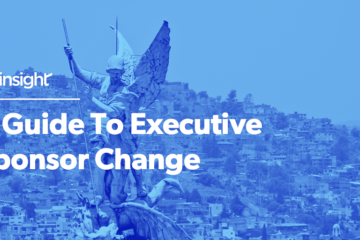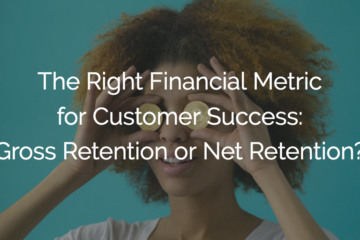[Video] Beyond Performance: How Narrative, Targeting & Sequencing affect Fundraising
[Original interview posted at Scale Venture Partners]
Many variables go into closing a successful venture capital round. Your company’s performance on core metrics is probably the biggest one, and most of the time you should care about optimizing that first. But as Nick Mehta explains, entrepreneurs may underestimate how much impact Narrative, Targeting & Sequencing can have on your fundraising — sometimes going as far as letting you close a round in frothy times, even if your core metrics aren’t all that great. I caught up with the CEO of Customer Success success Gainsight the week after Dreamforce. (Hope the knee is feeling better, Nick!)
Dreamforce
Tim Anglade, Executive in Residence at Scale Venture Partners: You were like at Dreamforce last week, and it seems like you did a dozen sessions or something that–
Nick Mehta, CEO at Gainsight: That we did a lot of sessions. I think we had, I think we had 10 sessions as a company or something, but I was on a bunch of them. We did a bunch of dinners, and breakfasts and lunches, and your Dreamforce if you’re an application company, It’s like, it’s your thing, right.
Tim: Yeah, it’s kinda crazy. It seem like to drive so much of like deal activity, it really is something, like very quickly, like a lot of companies, even investors sometime, like their year revolves around that. It such a big opportunity.
Nick: Yeah, Dreamforce, you really have to learn how to run it. It’s an art just in terms of how to hack it. What to, basically how to use the time well, how to use your money well. You know a lot of times over the first time you do it, you think, okay, I just buy a booth and everything works great. It turns out there’s all these hacks like getting a restaurant and buying out a restaurant that’s next to Moscone and then you do your meetings there, and figuring out what restaurants are the best places to hold dinners, and knowing that the night of the YouTube concert you’re gonna have more drop-off in attendance if you have an event and things like that.
The Art of Fundraising
Tim: The topic I wanted to chat with you about, everybody told me like, “Oh you gotta talk to Nick fundraising” and you seem to be seen as like a big expert on a lot of that stuff. And it seems like it’s similar thing. Everybody has to think about it, and everyone has their own little personal recipe. So I wanted to get your take on the art of fundraising, and how to think about that.
Understanding your situation and realizing which fundraising advice is gonna apply to you is a very, very big thing.
Nick: Yeah, it’s funny ‘cause I talked to a lot of entrepreneurs and I think everyone would love to have a formula. Probably unlike Dreamforce, it’s not as simple as like a small number of variables you just have to optimize. There’s really a lot. It’s very situational of course, right? But I do think understanding your situation and realizing what advice is gonna apply to you is a very, very big thing. Like I think a lot of entrepreneurs kinda read blog posts about fundraising, and think that all of it applies to them, but it’s where they are, either in the market they’re in, the time that they’re raising, the size of their company, their experience level. Those like change what you do a lot, right? So if you think about being in a good market, if you’re an experienced entrepreneur and you’re going after something that’s pretty clear and it’s a big market and you have some traction already, versus first-time entrepreneur, versus somebody going after what looks like a niche market whether it is or not, right? And so all of this stuff really varies a lot, but I’d say the first thing is actually literally figuring out who you are and like what’s different about your situation from others, versus assuming that your fundraising is gonna be like everyone else’s. That’s like a big thing.
Fundraising is a range of outcomes, not a binary yes/no
Tim: No, that makes sense and it also seem like of course the biggest one of those differences is like how your company is doing on its own, right? At whatever stage you’re at, and it’s kind of, it still feels true to my mind that if your company is not doing well you’re not gonna have an easy time raising a round. There’s no amount of fundraising as its own thing that you can do on top of a bad company attempting to win a round. Does that feel correct to you still?
Generally speaking, for most companies, there’s a range of prices at which you can get funded once you get to a certain stage
Nick: Well, I mean it’s funny, because, are you generally speaking, most companies, there’s a range of prices that which something can get funded once you get to a certain stage. I think that the core range is defined by how your company is doing, how the market’s doing, what the timing is. Your ability to actually get the fundraising determines where you fall in that range, right. So if you have a very compelling pitch, you organize your process while you target the investors that are likely to resonate with you. You’re able to communicate with them well. You have the right team. You’re gonna get the high-end of that range, both in term range and range in terms of deal, but also time to get it done. Or even terms, but also time to get it done. Meaning like how much do you have to invest. And if you’re less effective, you’re gonna get in the low end of that range. Right now, once you get to a certain point, the deal could just not get done which is obviously a problem, but I think that I guess the way that I’d put it is your execution of fundraising determines where you fall in the range. The success of your business and the external market factors determine which range you’re in, right?
Performance Rounds vs. Narrative Rounds
Tim: Right, yeah, you’re right and those market factors are interesting ‘cause obviously you know when the market does better, it’s like easy to get money even at like an A, B, C stage, right? And you know a later round is always almost based on performance revenue, the core metrics.
Nick: Yeah, the further you go, more performance for sure.
Tim: But early on and kinda times of boom, it’s easier to get money just on like narrative. We’re gonna disrupt X and even if you have zero revenue you can probably get a B somewhere. Somebody will give you a big check, but in times like even in right now, I wouldn’t say we’re in like cold times per se, but it seems like it’s much harder, right? This kind of narrative driven rounds, like middle rounds, are really hard to get these days and people kind of really look at your metrics.
Nick’s 3 Fundraising Tips
Tim: Assuming you have kinda okay to good metrics to great metrics, what are some of the things you feel like really help you once you have to go into fundraising mode?
Nick: If you’re withing that range, and assuming that it’s the right time, or a reasonably good time to fundraise, I think there’s a few things.
So number one is targeting the right investors. That’s actually something I think a lot of people don’t spend enough time on. There’s so many people you can target and sometimes I get a request from an entrepreneur and says “Can I get an intro to…” and they list out like 10 people that are really totally different, I’m like, “Are you sure they all “are gonna be interested in your company?” You know, ‘cause you think about that investor, they’re gonna probably make one or two investments a year. So what’s gonna cause them to wanna invest in your company, right? So I think the targeting of the investors is the first thing.
It’s easier if investors have known you for a while, so really think about how you build relationships ahead of time in an authentic way — how to get them to see the progress of your company
Second thing is actually the relationship you build with those investors. I think that most people know this, but it really is, it’s very true, which is, it’s hard to go get a deal done with somebody you met for the first time. Now it’s very, it’s possible. It’s not like it doesn’t happen, but you know, it’s not, it’s more easier if they’ve known you for a while, and so really thinking about how you build relationships ahead of time in an authentic way, how to get people to kinda see the progress of your company. I think Mark Suster wrote that post. He invests in lines not dots which I think is very powerful where he wants to see some, a company kinda progress over time. So the second thing is really getting to know people over time. Now that’s, it’s hard. Like usually when people start thinking about fundraising, they have to raise money. So you have to do this sort of before you have to raise money.
Now the third thing I think is understanding the sequencing. Now this is where there is some art, right? There is some thinking about, am I gonna try to do all this together at once? I might try to organize it so they happen at the same time versus am I gonna do this serially over time? There’s a little bit of balancing those two. On one extreme, you’ve got like meet with one firm, then the next week when they met another, then the next week meet another. That’s not very effective ‘cause you can’t get like a process where things converge and where people feel like something’s gonna happen. On the other hand though, I’ve seen entrepreneurs be like, “I’m gonna meet with 40 firms all at once.” And the problem with that is, number one, it gets around that you’re shopping around your deal, and it feels like you’re not very targeted. Number two, if all of those people say no, you’re kind of in trouble So I would say there’s a balance of like finding a small number of firms that you feel like there’s genuinely a good fit based on personal relationship, based on their interest in your sector, and then doing that in a concise period of time. That’s the next thing.
Tim: Yeah, that makes sense. I mean that personal relationship is something I hear like so often, but I think so many entrepreneurs do wrong of like talk to like investors even when you’re not raising money. Particularly when you’re not raising money, when you have no pressure, when you can kinda give them access to whatever you want about your business, any metrics, just start establishing those dots on the line, right. That’s such a critical thing to be in a good position once you’re actively want to fundraise and devote a lot of time.
Sequencing can Make or Break your Round
Tim: But let’s talk about timing at like a macro and micro sense ‘cause in my experience those things kind of actually determine your outcomes quite a bit. And so, it seems like there’s seasons during the year where you should try to fundraise and seasons you should absolutely avoid. So Thanksgiving, holidays, it seems like all the VCs are on vacation. Everybody’s skiing in like Colorado or whatever, and it’s really hard to fundraise. And it seems to me that the hot season would be just before that, like right now, like September, you know, October, the perfect season, or early in the year like January, February, March. It worked pretty well for me, so does that line up with you?
The simplest way to think about it is the school calendar kinda drives a lot of it
Nick: Generally, and maybe I would add one in in the sort of like April, May timeframe before people go to summer. The simplest way to think about it is the school calendar kinda drives a lot of it, right, at least in the U.S., and so I think that, you know, folks are gonna be with their families and all that during a lot of that school downtime. So you really want to get one of those three windows. Now it’s not always easy. Deals do happen in the summer and other times too, but I think that if you wanna get the most people that could potentially look at your deal, you really have to hit one of those three windows, which again, you have to think about planning in advance. The other variable, that’s like an external calendar factor, I think the internal calendar factor is you certainly want to raise based on when your company is doing well, right? And it’s kind of obvious, but if you had some amazing milestones, some amazing deals, some amazing hire, you just had your big company conference, something that’s like really powerful, also consider then and those things could be tied together as well.
Tim: Right, and that can be like a good sign of momentum. In a very, very micro sense, it still seems like fundraising is really driven by also like weekly calendar of the firm. Then like that Monday partner meeting, right? And so you really have to worry about like when you would be go up and presenting ‘cause you’re probably not getting around without presenting in front of all the partners on some Monday meetings or a bunch of them, you know, ideally, right? So, it’s co-pacing that and timing that is kinda really, really critical.
Nick: That’s right and that has become a fixed block. So you had to think about if, if you want your process to converge, the ideal situation is over maybe two weeks, you do your partner meetings, or three weeks, and maybe it’s one day, but that’s probably pretty hard, but like at least a few weeks, you get to meet all the partnerships. You get to know them, get to feel them out, they feel you out. If you have one partner meeting and another one eight weeks later, the probability of those two deals both happening at the same time is pretty low.
Tim: Yeah, because it is also still a bit of like, honestly like fear of missing out, FOMO, but like some competitor pressure at least, right, between investors.
Remember: Startups are Illiquid Financial Instruments
The value of a startup is pretty opaque, so with a lot of VCs, what ends up happening is, if nobody else is interested in this company, they start going “ what am I missing?”
Nick: Well it’s interesting, ‘cause there really are two dynamics, right. One is the competitor pressure, the FOMO like you talked about. The other one is, you know, if you’re familiar with kind of like the lemon theory and car, in used cars. You know lemon theory if people don’t know it, is the idea that in some markets, the value of something is pretty opaque. A lot of things in the stock market, the value of something is very transparent. You can say the stock is worth x, right? But the value of a startup is pretty opaque, and so I think a lot of VCs, what ends up happening is, if there’s negative signals, like for example, nobody else is interested in this company, that starts being like what am I missing? And by the way, some investors are great. They’re independent, but a lot of them may be like “What am I missing?” and maybe this isn’t the right company, and so if you start sending off the wrong signals, like you’re too desperate, nobody’s interested, you can actually kinda make people think your company is a lemon.
Tim: Yeah, it’s kinda crazy ‘cause at the end of the day, startups are a very like illiquid and inefficiently priced instrument, right? So, that’s where you get so many different weird pieces of advice from different people about different situation and so I think that advice is really good, right. You have to think about the unique kind of aspect of your own situation of your own company. You have to work the timing. You have to be aware of a price, an offer, a term sheet not really like staying around forever.
Nick: That’s right.
Tim: So it makes a lot of sense. Thanks a lot, Nick.
Nick: Yeah, thank you! Great talking to you.



